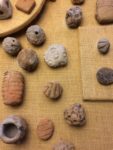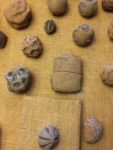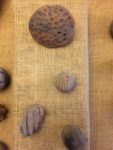The Poverty Point hunter-gatherer culture of Louisiana is renowned for having built mounds with concentric rows of curved earthwork ridges. It was built between 1700 and 1100 B.C. and is the largest Native American construction known from that period. The 400-acre mound site in Epps, Louisiana, 260 miles northwest of New Orleans, is today a state park and UNESCO World Heritage Site.
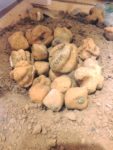 An enormous quantity of archaeological artifacts have been found at Poverty Point. Among the most numerous are PPOs, ie, Poverty Point Objects, which may sound like a rather all-encompassing term, but refers to specific things: baked balls of earth less than two inches in diameter. Millions of them have been discovered at Poverty Point, mostly grouped together in hearths and cooking pits along the artificial earthenwork ridges where the PP people lived. Standard PPOs were this culture’s version of cooking rocks. Their territory had no stone to speak of, so they dug up the loess soil, formed it into lumps and fired them creating a man-made version.
An enormous quantity of archaeological artifacts have been found at Poverty Point. Among the most numerous are PPOs, ie, Poverty Point Objects, which may sound like a rather all-encompassing term, but refers to specific things: baked balls of earth less than two inches in diameter. Millions of them have been discovered at Poverty Point, mostly grouped together in hearths and cooking pits along the artificial earthenwork ridges where the PP people lived. Standard PPOs were this culture’s version of cooking rocks. Their territory had no stone to speak of, so they dug up the loess soil, formed it into lumps and fired them creating a man-made version.
Six different shapes have been identified, and while there are some anomalous examples that don’t fit any of the shape templates, the overwhelming majority of the balls were formed in these six designs. It’s 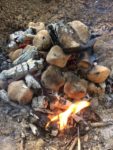 not clear why they were made that way or what function these distinct forms may have performed. We do know that they were traded, exchanged or transported over significant distances because PPOs have been found in Florida, the Midwest and the South. Some of the fired earth balls found at Poverty Point came from those locations as well, as analysis of the soil origin confirms. Archaeologists now hypothesize that Poverty Point may have been a pilgrimage site, that visitors took cooking balls on the pilgrim road with them, leaving some behind, and took some PPO originals home with them as souvenirs of their pilgrimage.
not clear why they were made that way or what function these distinct forms may have performed. We do know that they were traded, exchanged or transported over significant distances because PPOs have been found in Florida, the Midwest and the South. Some of the fired earth balls found at Poverty Point came from those locations as well, as analysis of the soil origin confirms. Archaeologists now hypothesize that Poverty Point may have been a pilgrimage site, that visitors took cooking balls on the pilgrim road with them, leaving some behind, and took some PPO originals home with them as souvenirs of their pilgrimage.
But what about those exceptions, the balls that eschew the standard PPO shapes of their millions of siblings? Archaeologists call them Decorated PPOs. They are made of baked earth, but they do not appear to have been used for cooking. They were not found in clusters on hearth sites. They are elaborately decorated with cups, circles, swirls, bands. Some are flat, cubical or rectangular.
The forms are generally pretty abstract, so the meaning of the shapes is unknown. Even so, patterns have emerged because some of the forms are repeated. This might suggest that the same artist created multiple Decorated Objects, or several people were attracted to the same theme, whatever that meaning might be.
And while, it’s clear that this culture had some abstract thought behind the creation of many Decorated Objects, others follow a very naturalistic design as you would suspect from a hunter-gatherer culture! You’ll see a number of recognizable things depicted here, like a spider web, a lotus pod, the sun, or even the potential form of an owl with two big eyes carefully indented by ancient fingertips.
It’s also important to know that these sorts of Decorated PPOs traveled just like some of the standard varieties. Among these, are some objects seen here that you might think look like dice. These are made from white, kaolinitic clay-rich soils from along the Tennessee River Valley. These are at least one decorated variety we are sure were imported. Some of the mottled grey balls, which are often called mulberry forms, are likely made from soils found along the Gulf Coast.
So Poverty Point World Heritage Site’s Facebook page opens the question to the public: what were these decorated PPOs used for if not cooking? Were they art? Gamepieces? Perhaps there’s a link to the pilgrimage idea, that the balls grew more abstract and highly decorative as the tradition of taking home standard PPOs became widespread and pilgrims sought out more diverse forms. It’s the Native American version of Scotland’s mysterious Neolithic balls.
